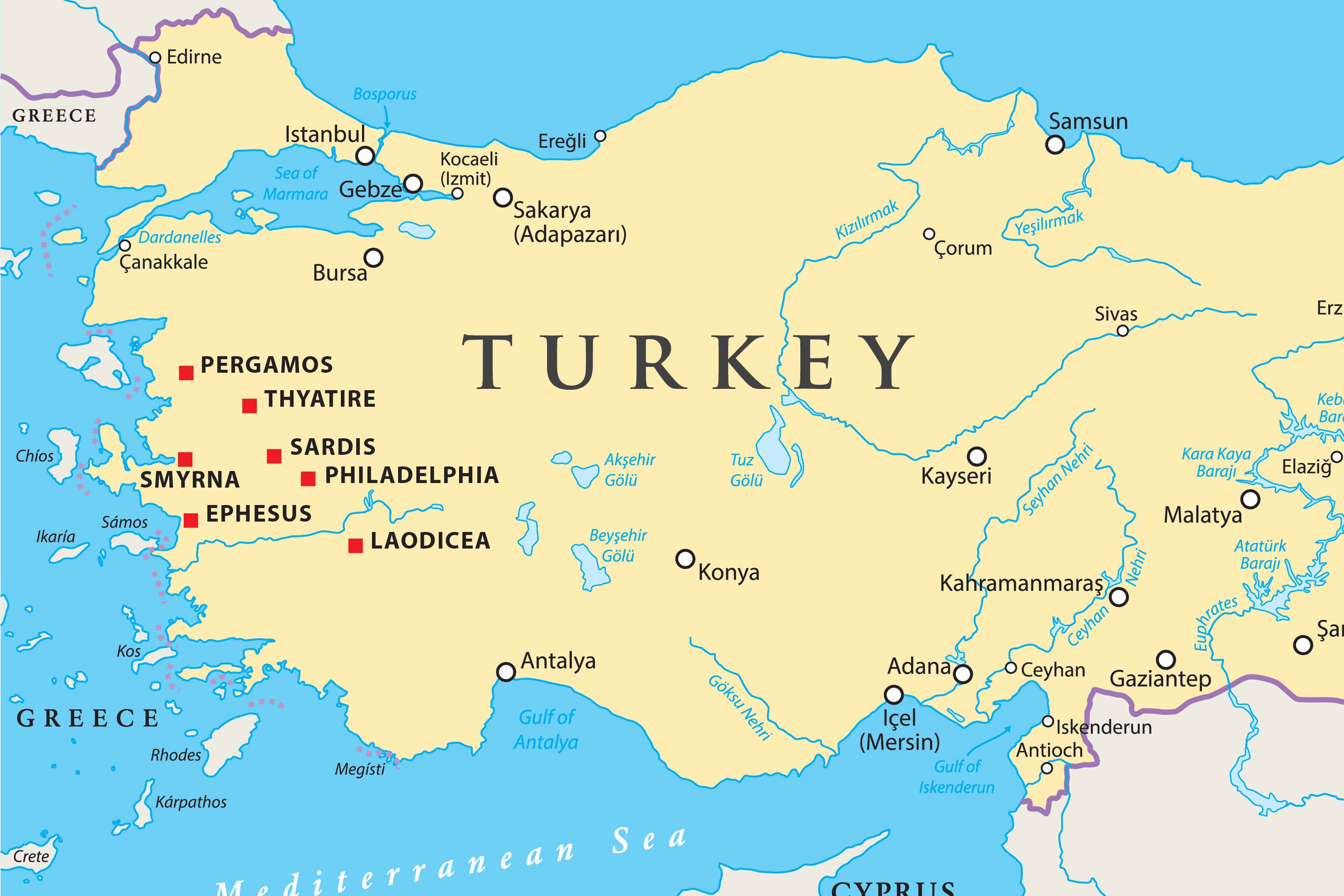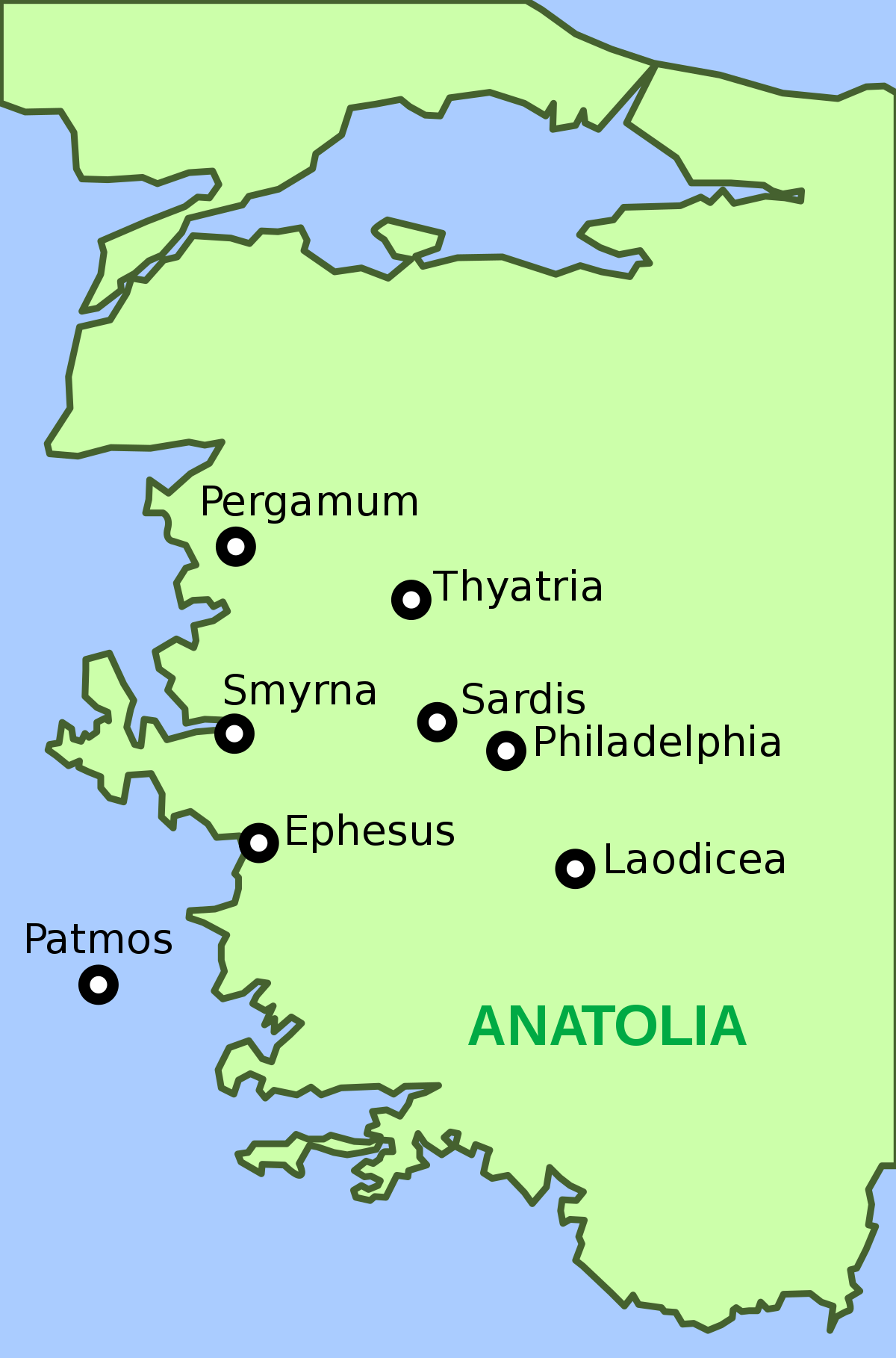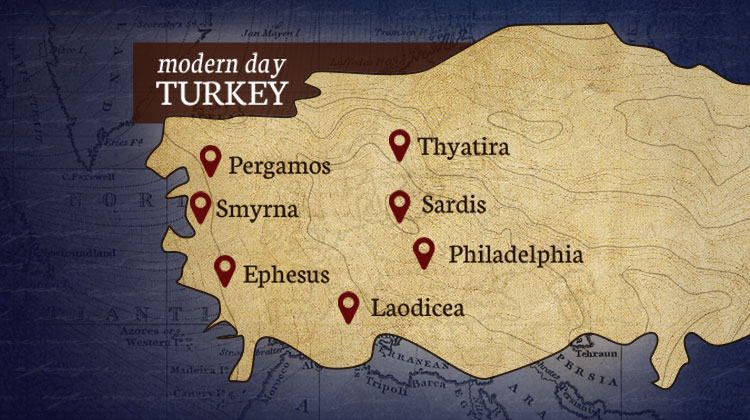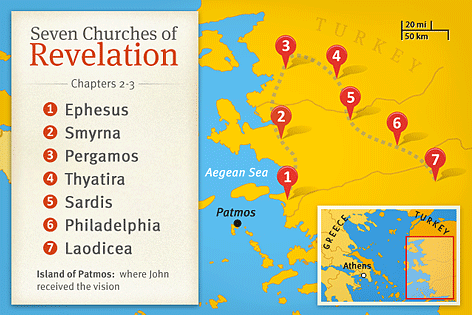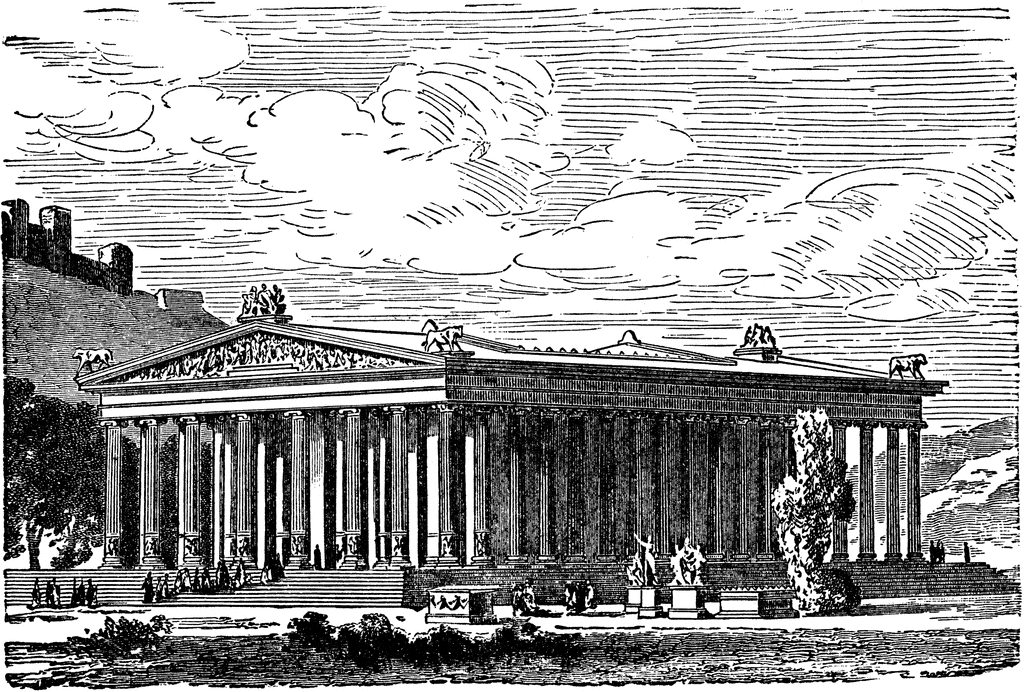|
Réponse |
Message 1 de 17 de ce thème |
|
Temple of Artemis
From Wikipedia, the free encyclopedia
 This model of the Temple of Artemis, at Miniatürk Park, Istanbul, Turkey, attempts to recreate the probable appearance of the third temple. 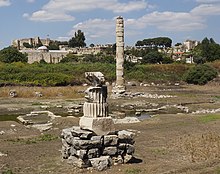 The site of the temple in 2017.  Timeline and map of the Seven Wonders of the Ancient World, including the Temple of Artemis
The Temple of Artemis or Artemision (Greek: Ἀρτεμίσιον; Turkish: Artemis Tapınağı), also known as the Temple of Diana, was a Greek temple dedicated to an ancient, localised form of the goddess Artemis (equated with the Roman goddess Diana). It was located in Ephesus (near the modern town of Selçuk in present-day Turkey). By AD 401 it is believed it had been ruined or destroyed.[1] Only foundations and fragments of the last temple remain at the site.
The earliest version of the temple (a Bronze Age temenos) antedated the Ionic immigration by many years. Callimachus, in his Hymn to Artemis, attributed it to the Amazons. In the 7th century BC, it was destroyed by a flood.
Its reconstruction, in more grandiose form, began around 550 BC, under Chersiphron, the Cretan architect, and his son Metagenes. The project was funded by Croesus of Lydia, and took 10 years to complete. This version of the temple was destroyed in 356 BC by an arsonist, commonly thought to have been a madman named Herostratus.
The next, greatest, and last form of the temple, funded by the Ephesians themselves, is described in Antipater of Sidon's list of the world's Seven Wonders:
I have set eyes on the wall of lofty Babylon on which is a road for chariots, and the statue of Zeus by the Alpheus, and the hanging gardens, and the colossus of the Sun, and the huge labour of the high pyramids, and the vast tomb of Mausolus; but when I saw the house of Artemis that mounted to the clouds, those other marvels lost their brilliancy, and I said, "Lo, apart from Olympus, the Sun never looked on aught so grand".[2]
Location and history
[edit]
 The fame of the Temple of Artemis was known in the Renaissance, as demonstrated in this imagined portrayal of the temple in a 16th-century hand-colored engraving by Martin Heemskerck.
The Temple of Artemis (artemisia) was located near the ancient city of Ephesus, about 75 kilometres (47 mi) south from the modern port city of İzmir, in Turkey. Today the site lies on the edge of the modern town of Selçuk.
The sacred site (temenos) at Ephesus was far older than the Artemision itself. Pausanias was certain that it antedated the Ionic immigration by many years, being older even than the oracular shrine of Apollo at Didyma.[3] He said that the pre-Ionic inhabitants of the city were Leleges and Lydians. Callimachus, in his Hymn to Artemis attributed the earliest temenos at Ephesus to the Amazons, legendary warrior-women whose religious practise he imagined already centered upon an image (bretas) of Artemis, their matron goddess. Pausanias believed that the temple pre-dated the Amazons.[3]
Pausanias's estimation of the site's antiquity seems well-founded. Before World War I, site excavations by David George Hogarth seemed to identify three successive temple buildings. Re-excavations in 1987–1988 and re-appraisal of Hogarth's account[a] confirmed that the site was occupied as early as the Bronze Age, with a sequence of pottery finds that extend forward to Middle Geometric times, when a peripteral temple with a floor of hard-packed clay was constructed in the second half of the 8th century BC.[b] The peripteral temple at Ephesus offers the earliest example of a peripteral type on the coast of Asia Minor, and perhaps the earliest Greek temple surrounded by colonnades anywhere.
In the 7th century BC, a flood[4] destroyed the temple, depositing over half a meter of sand and flotsam over the original clay floor. Among the flood debris were the remains of a carved ivory plaque of a griffin and the Tree of Life, apparently North Syrian, and some drilled tear-shaped amber drops of elliptical cross-section. These probably once dressed a wooden effigy (xoanon) of the Lady of Ephesus, which must have been destroyed or recovered from the flood. Bammer notes that though the site was prone to flooding, and raised by silt deposits about two metres between the 8th and 6th centuries, and a further 2.4 m between the sixth and the fourth, its continued use "indicates that maintaining the identity of the actual location played an important role in the sacred organization".[5]
The new temple was sponsored at least in part by Croesus,[6] who founded Lydia's empire and was overlord of Ephesus.[c] It was designed and constructed from around 550 BC by the Cretan architect Chersiphron and his son Metagenes. It was 115 m (377 ft) long and 46 m (151 ft) wide, supposedly the first Greek temple built of marble. Its peripteral columns stood some 13 m (40 ft) high, in double rows that formed a wide ceremonial passage around the cella that housed the goddess's cult image. Thirty-six of these columns were, according to Pliny the Elder, decorated by carvings in relief. A new ebony or blackened grapewood cult statue was sculpted by Endoios,[d] and a naiskos to house it was erected east of the open-air altar.
|
|
|
|
Réponse |
Message 3 de 17 de ce thème |
|
Rediscovery of the temple
[edit]
 Reconstructive plan of Temple of Artemis at Ephesus according to John Turtle Wood (1877)
The site of the temple was rediscovered in 1869, after six years of searching by an expedition led by John Turtle Wood and sponsored by the British Museum. These excavations continued until 1874.[36] A few further fragments of sculpture were found during the 1904–1906 excavations directed by David George Hogarth. The recovered sculptured fragments of the 4th-century rebuilding and a few from the earlier temple, which had been used in the rubble fill for the rebuilding, were assembled and displayed in the "Ephesus Room" of the British Museum.[37] In addition, the museum has part of possibly the oldest cache of coins in the world (600 BC) that had been buried in the foundations of the Archaic temple.[38]
Today the site of the temple, which lies just outside Selçuk, is marked by a single column constructed of miscellaneous fragments discovered at the site.
Cult and influence
[edit]
The archaic temenos beneath the later temples clearly housed some form of "Great Goddess" but nothing is known of her cult. The literary accounts that describe it as "Amazonian" refer to the later founder-myths of Greek émigrés who developed the cult and temple of Artemis Ephesia. The wealth and splendor of temple and city were taken as evidence of Artemis Ephesia's power, and were the basis for her local and international prestige: despite the successive traumas of Temple destruction, each rebuilding – a gift and honor to the goddess – brought further prosperity.[i] Large numbers of people came to Ephesus in March and in the beginning of May to attend the main Artemis Procession.[41]
Artemis' shrines, temples and festivals (Artemisia) could be found throughout the Greek world, but Ephesian Artemis was unique. The Ephesians considered her theirs, and resented any foreign claims to her protection. Once Persia ousted and replaced their Lydian overlord Croesus, the Ephesians played down his contribution to the temple's restoration. On the whole, the Persians dealt fairly with Ephesus, but removed some religious artifacts from Artemis' Temple to Sardis and brought Persian priests into her Ephesian cult; this was not forgiven.[42] When Alexander conquered the Persians, his offer to finance the temple's second rebuilding was politely but firmly refused.[j] Ephesian Artemis lent her city's diplomacy a powerful religious edge.
Under Hellenic rule, and later, under Roman rule, the Ephesian Artemisia festival was increasingly promoted as a key element in the pan-Hellenic festival circuit. It was part of a definitively Greek political and cultural identity, essential to the economic life of the region, and an excellent opportunity for young, unmarried Greeks of both sexes to seek out marriage partners. Games, contests and theatrical performances were held in the goddess's name, and Pliny describes her procession as a magnificent crowd-puller; it was shown in one of Apelles' best paintings, which depicted the goddess's image carried through the streets and surrounded by maidens.[45] In the Roman Imperial era, the emperor Commodus lent his name to the festival games, and might have sponsored them.[46]
From the Greek point of view, the Ephesian Artemis is a distinctive form of their goddess Artemis. In Greek cult and myth, Artemis is the twin sister of Apollo, a virgin goddess of the hunt, the wilderness and the moon, who, despite being a goddess of childbirth was nevertheless known for her chastity. At Ephesus, a goddess whom the Greeks associated with Artemis was venerated in an archaic, pre-Hellenic cult image[47] that was carved of wood (a xoanon) and kept decorated with jewelry.
The features are most similar to Near-Eastern and Egyptian deities, and least similar to Greek ones. The body and legs are enclosed within a tapering pillar-like term, from which the goddess' feet protrude. On the coins minted at Ephesus, the goddess wears a mural crown (like a city's walls), an attribute of Cybele as a protector of cities (see polos).[47]
 Traditional many-breasted interpretation in a 16th-century fountain of Diana Efesina, Villa d'Este, Tivoli, Italy
The traditional interpretation of the oval objects covering the upper part of the Ephesian Artemis is that they represent multiple breasts, symbolizing her fertility. This interpretation began in late antiquity and resulted in designations of the Ephesian goddess as Diana Efesia Multimammia and other related descriptions.[48][page needed] This interpretation was rooted in Minucius Felix and Jerome's Christian attacks on pagan popular religion, and modern scholarship has cast doubt on the traditional interpretation that the statue depicts a many-breasted goddess.[48][page needed]
Evidence suggests that the oval objects were not intended to depict part of the goddess' anatomy at all. In some versions of the statue, the goddess' skin has been painted black, likely to emulate the aged wood of the original, while her clothes and regalia, including the so-called "breasts", were left unpainted or cast in different colors.[48][page needed]
Fleischer (1973) suggested that instead of breasts, the oval objects were decorations that would have been hung ceremonially on the original wood statue (possibly eggs, or the testicles of sacrificed bulls[49]), and which were incorporated as carved features on later copies.[48][page needed] The "breasts" of the Lady of Ephesus, it now appears, were likely based on amber gourd-shaped drops, elliptical in cross-section and drilled for hanging, that were rediscovered in the archaeological excavations of 1987–1988. These objects remained in place where the ancient wooden statue of the goddess had been caught by an 8th century flood. This form of jewelry, then, had already been developed by the Geometric Period.[50][51]
 Farnese Artemis Farnese Artemis (2nd century) in the National Archaeological Museum, Naples (no. 6278)
On the coins she rests either arm on a staff formed of entwined serpents or of a stack of ouroboroi – the eternal serpent with its tail in its mouth. In some accounts, the Lady of Ephesus was attended by eunuch priests called "Megabyzoi"; this might have been either a proper name or a title. The practice of ritual self-emasculation as qualification to serve a deity is usually identified with Cybele's eunuch mendicant priests, the Galli. The Megabyzoi of Ephesian Artemis were assisted by young, virgin girls (korai).[k][54]
A votive inscription mentioned by Bennett (1912),[55] which dates probably from about the 3rd century BC, associates Ephesian Artemis with Crete:
- "To the Healer of diseases, to Apollo, Giver of Light to mortals, Eutyches has set up in votive offering [a statue of] the Cretan Lady of Ephesus, the Light-Bearer."
The Greek habits of syncretism assimilated all foreign gods under some form of the Olympian pantheon familiar to them – the interpretatio graeca – and it is clear that at Ephesus, the identification with Artemis that the Ionian settlers made of the "Lady of Ephesus" was slender. Nevertheless, later Greeks and Romans identified her with both Artemis and Diana, and there was a tradition in ancient Rome that identified her with the goddess Isis as well.[48][page needed]
The Christian approach was at variance with the syncretistic approach of pagans to gods who were not theirs. A Christian inscription at Ephesus suggests why so little remains at the site:
- Destroying the delusive image of the demon Artemis, Demeas has erected this symbol of Truth, the God that drives away idols, and the Cross of priests, deathless and victorious sign of Christ.[56]
The assertion that the Ephesians thought that their cult image had fallen from the sky, though it was a familiar origin-myth at other sites, is only known for the temple at Ephesus from Acts 19:35:
- After the city secretary quieted the crowd, he said, “Men of Ephesus, what person is there who does not know that the city of the Ephesians is the keeper of the temple of the great Artemis and of her image that fell from heaven?"
Lynn LiDonnici observes that modern scholars are likely to be more concerned with origins of the Lady of Ephesus and her iconology than her adherents were at any point in time, and are prone to creating a synthetic account of the Lady of Ephesus by drawing together documentation that ranges over more than a millennium in its origins, creating a falsified, unitary picture, as of an unchanging icon.[57]
A 360 degree panoramic view of the site of the temple
|
|
|
|
Réponse |
Message 4 de 17 de ce thème |
|
Temple of Artemis at Ephesus Facts and Mother Goddess Cult
The worship of Cybele-Artemis and the social structure of the temple:
The history of the Temple of Artemis at Ephesus dates back to 9000 years ago. Many statues of Cybele and Artemis have been discovered in Turkey. Those found in Catalhöyük, (dated to 7000 B.C.) and Hacilar (dated to 6000 B.C.) are the oldest. These statues were made of baked clay, and since they were intended to look reproductive, their hips, breasts and genital organs were exaggerated. Although these were initially thought to be Venus statues, later it was established that they represented the mother goddess. As time went by, the mother goddess changed form and her popularity spread everywhere in the prehistoric world. She acquired the local characteristics but never lost her essence.
 Mother goddess from Catalhöyük (Anatolia), (about 6000-5500 BC), today in Museum of Anatolian Civilizations in Ankara, Turkey. Mother goddess from Catalhöyük (Anatolia), (about 6000-5500 BC), today in Museum of Anatolian Civilizations in Ankara, Turkey.
Worship of Cybele and Artemis in Anatolia
Although we do not know what the people of Catalhöyuk and Hacilar called the mother goddess, she was known as Isis in Egypt, Latin Arab lands, Kubala, Cybele, Hepa and Artemis in Anatolia. Cybele was the most popular name in Anatolia and was worshipped the most. Her famous temple and cult centre is in Persinus Oren (village of Ballhisar) of Sivrihisar near Ankara. The evolution of the mother goddess in antiquity reached a turning point in Pessinus which was an important centre in Phyrigia. Here, she seems diopetic (from the sky). In Pessinus, a meteorite similar in shape to her diopetic form was worshipped for many years as the statue of Cybele.
 The goddess Cybele, stele relief from Pessinus, Turkey. Phrygian civilization, 2nd century BC. Ankara The goddess Cybele, stele relief from Pessinus, Turkey. Phrygian civilization, 2nd century BC. Ankara
In the reliefs found in many locations in Phyrigia (some of them on rocks), the figure of the mother goddess was carved without detail, similar to her diopetic form. During the reign of Attalos I, the King of Pergamum, the meteorite was taken to Rome, in the hope that it would help end the war between Rome and Carthage with the victory of Rome. It was erected on Platina hill. The mother goddess also has a Xoanic form. Xoanic means “carved out of wood”. The oldest statue of Artemis in Ephesus is thought to be of Xoanic type, carved out of wood without detail.
Roman Adoption and Rituals
The mother goddess who was taken to Rome from Pessinus received a great deal of respect. Elagabalus, one of the Roman emperors, during a ceremony, cut off his male organ as required according to the worship of Cybele, and presented it to the mother goddess. The incident proves the respect she received in Rome.
 The Great Artemis and Beautiful Artemis Statues from Ephesus Archaeological Museum The Great Artemis and Beautiful Artemis Statues from Ephesus Archaeological Museum
The fact that Cybele-Artemis always looked definitely eastern becomes evident when her statues in the Ephesus Museum are examined. The legs of the statues are motionless as though fused. Although the nodes on her chest were once thought to be breasts, it has become apparent that they represent the testes of bulls sacrificed for her. Testes symbolize fertility since they produce “seeds”. The bulls, lions and sphinxes that are on her skirt, indicate that she was the protectress of animals. The lions depicted on both sides of Cybele in her reliefs are seen on her arms in these statues.
The Priesthood and Its Hierarchy
The hierarchy among the priests in the temple was different from the hierarchy in the West. Even the terms used were different from the terms used by the Greeks, although, during the Roman period, Greek was used.
 The Temple of Artemis at Ephesus – Then & Now The Temple of Artemis at Ephesus – Then & Now
The temple was administered by only a few priests. The male organs of these priests and the head priest called Megaysos were removed. According to Strabo, the priests were chosen from the middle of Anatolia and especially from the east. Becoming Megabysos meant assuming a very honourable duty. The assistants of Megabysos were virgins similar to the Vestal Virgins of Rome. Some say that the worship of Artemis, the Temple of Artemis and the religious hierarchy were all modelled on the social structure of bees. The bee was the symbol of Ephesus, and it is often seen on coins and statues in Ephesus.
 Ephesian Artemis and Queen Bee reliefs on a coin Ephesian Artemis and Queen Bee reliefs on a coin
Another class of priests who served Artemis was called the Curetes. According to mythology, Curetes were demigods related to Zeus. While Zeus was creating Dionysus from his leg, Curetes stayed by him and made a noise so that Hera could not hear anything. Also, while Leto was giving birth to Artemis, Curetes stayed by her and made a noise. Every year this event was celebrated by a festival in Ortygia known as the birthplace of Artemis.
 An illustration of Birthday Festivals of Artemis An illustration of Birthday Festivals of Artemis
Another class of twenty priests were thought to be probably involved with the dances which took place during ceremonies. They may be referred to as “the acrobats” or “the tiptoers”. The worship of Artemis and Cybele was the most important factor in the development of Ephesus. The number of priests, priestesses and guards reached hundreds.
 A Realistic Virtual Reconstruction of the Temple of Artemis at Ephesus A Realistic Virtual Reconstruction of the Temple of Artemis at Ephesus
The Temple as a Sanctuary and Bank
The Temple of Artemis at Ephesus also served as a bank. The Megabysos were in charge of accepting gifts either presented or entrusted to the temple and lending money from the temple’s treasury. The temple also had certain privileges. For example, anyone who seeks shelter in the temple enjoys immunity (right of asylum). Therefore, people often took refuge in the sacred area surrounding the temple.
 A Footage from Excavations in the Temple of Artemis at Ephesus – 1896 A Footage from Excavations in the Temple of Artemis at Ephesus – 1896
During the time of Alexander, the sacred area and the borders of the refuge were enlarged, and King Mithridates enlarged this area even more so that the sacred area stretched as far as the spot where an arrow shot from the pediment of the temple would land. Emperor Marcus Antonius, inspired by what Julius Caesar had done in Didyma, doubled this sacred area which thus included a section of the city too. Citizens critical of the fact that many criminals took refuge here and in other temples in the Empire, requested that the right asylum be lifted. In 22, Emperor Tiberius discussed the issue with the representatives of other famous temples. Yet the Temple of Artemis continued to serve as a refuge.
You May Also Like
https://www.bestephesustours.com/blog/temple-of-artemis-at-ephesus-facts-and-mother-goddess-cult.html |
|
|
|
Réponse |
Message 5 de 17 de ce thème |
|
Ephesus Artemis (Diana)
$4.00
Description
Artemis was the Greek goddess of the hunt and of fertility. This statue of her, found in the excavations at Ephesus, is flanked by two stags, animals which the goddess Artemis loved to hunt. Many images of sacrificial bulls are portrayed on her dress and head gear. Although her appearance has been described as “multi-breasted”, it is more likely that the globes around her chest were the testes of the sacrificial bulls, which were hung on the statue as a symbol of fertility.
During the time of Paul, there was a great disturbance when certain merchants thought that Paul had discredited the temple of Artemis. The people went to the theatre and shouted for two hours “Great is Artemis of the Ephesians” (Acts 19:23-34).
|
|
|
|
Réponse |
Message 6 de 17 de ce thème |
|
|
|
|
Réponse |
Message 7 de 17 de ce thème |
|
|
|
|
Réponse |
Message 8 de 17 de ce thème |
|
|
|
|
Réponse |
Message 9 de 17 de ce thème |
|
|
|
|
Réponse |
Message 10 de 17 de ce thème |
|
|
|
|
Réponse |
Message 11 de 17 de ce thème |
|
Temple of Diana at Ephesus
“The temple of Diana was the chief glory of the city. The style was Grecian. The length of the ground-plan was four-hundred and twenty-five feet and the breadth two-hundred and twenty feet. The structure was thus four times as large as the Pantheon at Athens. The statue of the goddess was one of the finest works of art ever produced. It was wrought of ivory and gold, and was a marvel of costliness and beauty. The temple was decorated with sculptures by Praxiteles and one of the masterpieces of Apelles. A representation of the temple was stamped on the coins and medals of the city."—Ridpath, 1885
https://etc.usf.edu/clipart/78900/78906/78906_dianatemple.htm |
|
|
|
Réponse |
Message 12 de 17 de ce thème |
|
Jano - xano - xacobo - Jacobo - san yago - santiago
Jano - Iano - Ianus - Ianua - Iacobus
el Hermes no es equiparable...es hermafrodita y bicéfalo
el Jano es bifronte
ya quisieran el Hermes y el Shiva tener lo del Jano...
Es que todos ellos son mensajeros,el contacto entre dioses y los hombres , arquitectos del universo y además poseen dos "vertientes"
JANUS CON LA LLAVE
Y EL GALLO
El Primer Día del Año, es decir, el Día Primero de Enero de cada Año es dedicado al Dios Jano, Janus, Cronos o Saturno, Iao, Baco, Iod-Hevé, Thoth, Hermes y Mercurio.
"Dupuis fue el primer erudito que identificó a San Pedro como Janus [el término janitor, originalmente el que tiene las llaves, deriva de janus]. Janus alternadamente deriva de Dianus (Día), un Dios de las horas de la luz del día, la forma masculina de Diana la Deidad “Lunar” [Venusta, mejor dicho]. Janus es considerado el Dios de las Puertas, especialmente responsable [como San Pedro] del Portal del Cielo. El mes de Enero es llamado después Janus. (...). En los antiguos días Janus estaba en el cielo medio en la salida del Sol alrededor del Solsticio de Invierno, abriendo así un Año Nuevo. Janus es no solamente competente para abrir y cerrar días y años, sino también guerra y paz. (...) Así como Janus conduce el círculo anual de los signos zodiacales, San Pedro conduce a los Doce Apóstoles del Cristianismo Romano. Hércules es llamado un Portador de la Maza, pero Llave y Maza pueden ser expresados como sinónimos en Latín: Hércules es por lo tanto, un portador de las Llaves igual que Janus."
"Las regiones del Cercano Oriente tienen la mayoría de la lluvia en invierno. Esto conduce al cuadro de Janus como Barquero a través de la inundación del invierno. (...) Janus como Barquero se refiere otra vez a la actividad de Pedro como pescador. Janus fue representado no solamente con la Llave del Cielo, sino también con una Vara Larga que puede ser reinterpretado como la Vara del pastor con la que San Pedro mira a las Ovejas (...)"
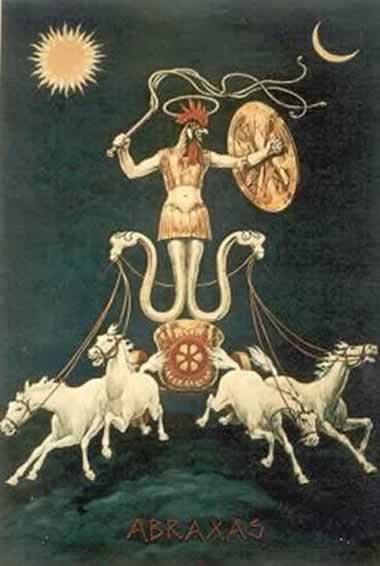
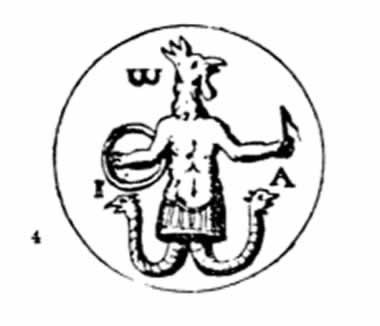
Antigua Gema Gnóstica con la figura del Abraxas y el Nombre Inefable de Dios IAW (IAO), el Anubis y Hermes-Cristo de los Gnósticos.
En la obra "The Gnostics and Their Remains", en el capítulo titulado "The Abraxas", su autor "Charles William King", [1887]", en referencias al Dios ANUBIS, lo describe
"... portando el caduceo de Hermes para denotar su oficio de conductor de almas [psicopompo], no… a través de las sombras del submundo, sino a lo largo del sendero planetario hasta su final reposo en el Pleroma. Así el Evangelio Gnóstico "Pistis Sophía", describiendo al Salvador [Jesús Cristo] después de haber recibido su Vestidura de Luz, con las cinco palabras de poder inscritas y con los nombres de todas las Dominaciones encontradas en su Ascensión, lo hace venir primero a la Puerta del Firmamento, luego al Dios de la esfera, luego a la esfera del Destino, y finalmente a los Doce grandes Aeones: cuyos Poderes todos cuando vieron sus propios nombres escritos en su vestidura quedaron impresionados con temor y comenzaron a cantar himnos a Él."
"Este ANUBIS-HERMES aparece algunas veces ondeando una rama de palma, para proclamar su victoria sobre los Poderes del Mal; o presidiendo a la psychostasia "peso de las almas", la escena comúnmente pintada en el Ritual Egipcio de la Muerte. En el último carácter, él aparece aquí como Cristo, el Juez;… En las antiguas Gemas griegas Hermes es a menudo representado inclinándose hacia adelante, con el caduceo en la mano, y por su mística virtud asistiendo a un alma emergiendo de la profundidad de la tierra -- una extraña coincidencia en forma, probablemente también en origen, con la medieval pintura del Salvador [Jesús el Cristo] sacando almas del Purgatorio…" […]
"Hermes en este particular carácter de Psychopompos, fue muy utilizado por los Naasenos (Ofitas) como el profético representante del Salvador en su grandioso oficio. Ellos interpretaron a Hermes conduciendo a las almas a través de la oscuridad dentro del Elysium así como Cristo guía las mentes del iluminado, fuera de la ignorancia, dentro del Conocimiento [Gnosis], en todo su especial sentido de las palabras…"
Un poco más adelante, este mismo autor, dice:
"Este doble carácter de ANUBIS es... expresado… [como[ el Buen Pastor, cargando un cordero sobre sus hombros, recostado sobre su cayado, sus lomos atados con un cinto [o ceñidor]… Pero un examen más detenido … se resuelve en el Dios de dos cabezas de Egipto… el "ladrador Anubis"… " ("The Gnostics and Their Remains".)
El "ladrador Anubis", en dos palabras: ¡El Veltro!
"... el gallo, heraldo del Sol, estaba consagrado al Dios Mercurio..." (Fulcanelli, “Las Moradas Filosofales”).
El Gallo (GAIO, o I.A.O.) es el atributo del Apóstol Pedro. Cuando el Gallo de la Alquimia, de la Pasión, Canta por tercera vez, es el anuncio de la Resurrección.
“El Gallo" es el emblema de la Resurrección. Simboliza también al Mercurio de la Alquimia, las Energías Creadoras Sexuales, que el Alquimista Transmuta por medio de “La Llave" que es el Arte y la Ciencia de la Transmutación Sexual, tal y como está en las Obras de nuestro Venerable y Amado Maestro Samael Aun Weor, de nuestro Venerable y Amado Maestro Rabolú y del V.M. Thoth-Moisés. (Ver nuestro Trabajo titulado “Preparación para ser un Fiel Discípulo de la Logia Blanca“).
El Divino Jerarca de la Ley de Dios Anubis es asimismo Hermes y Thoth:
"Hermanubis (Egipcio).- O sea: Hermes-Anubis, "el revelador de los misterios del mundo inferior" -no del infierno o Hades, como se ha interpretado erróneamente, sino de nuestra Tierra (el mundo más inferior de la cadena septenaria de mundos) -y también de los misterios sexuales. Kreuzer debe haber adivinado la verdadera interpretación, por cuanto denomina a Anubis-Thoth-Hermes "un símbolo de la ciencia y del mundo intelectual".
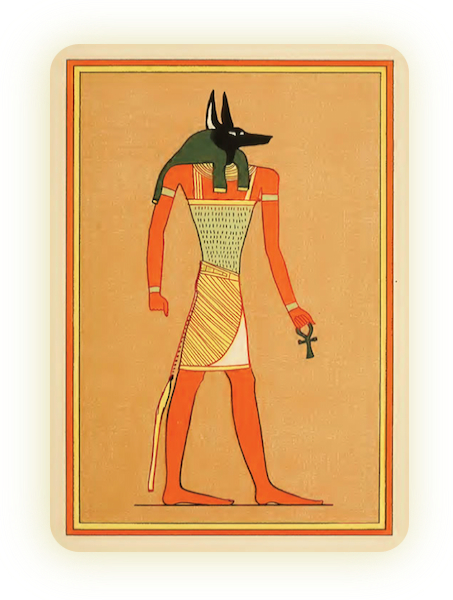
"Estaba siempre representado teniendo en la mano una cruz,..." (G.T. H.P.B.)", el "Ankh", la Cruz de Thoth.
http://www.burbuja.info/inmobiliaria/conspiraciones/462544-i0i-que-significa-8.html
|
|
|
|
Réponse |
Message 13 de 17 de ce thème |
|
Solar god theories
[edit]
According to Macrobius who cites Nigidius Figulus and Cicero, Janus and Jana (Diana) are a pair of divinities, worshipped as Apollo or the sun and moon, whence Janus received sacrifices before all the others, because through him is apparent the way of access to the desired deity.[51][52]
A similar solar interpretation has been offered by A. Audin who interprets the god as the issue of a long process of development, starting with the Sumeric cultures, from the two solar pillars located on the eastern side of temples, each of them marking the direction of the rising sun at the dates of the two solstices: the southeastern corresponding to the Winter and the northeastern to the Summer solstice. These two pillars would be at the origin of the theology of the divine twins, one of whom is mortal (related to the NE pillar, nearest the Northern region where the sun does not shine) and the other is immortal (related to the SE pillar and the Southern region where the sun always shines). Later these iconographic models evolved in the Middle East and Egypt into a single column representing two torsos and finally a single body with two heads looking at opposite directions.[53]
Numa, in his regulation of the Roman calendar, called the first month Januarius after Janus, according to tradition considered the highest divinity at the time.
 The temple of Janus with closed doors, on a sestertius issued under Nero in 66 AD from the mint at Lugdunum The temple of Janus with closed doors, on a sestertius issued under Nero in 66 AD from the mint at Lugdunum
Numa built the Ianus geminus (also Janus Bifrons, Janus Quirinus or Portae Belli), a passage ritually opened at times of war, and shut again when Roman arms rested.[54] It formed a walled enclosure with gates at each end, situated between the old Roman Forum and that of Julius Caesar, which had been consecrated by Numa Pompilius himself. About the exact location and aspect of the temple there has been much debate among scholars.[55] In wartime the gates of the Janus were opened, and in its interior sacrifices and vaticinia were held, to forecast the outcome of military deeds.[56] The doors were closed only during peacetime, an extremely rare event.[57] The function of the Ianus Geminus was supposed to be a sort of good omen: in time of peace it was said to close the wars within or to keep peace inside;[which?] in times of war it was said to be open to allow the return of the people on duty.[58]
A temple of Janus is said to have been consecrated by the consul Gaius Duilius in 260 BC after the Battle of Mylae in the Forum Holitorium. It contained a statue of the god with the right hand showing the number 300 and the left the number 65—i.e., the length in days of the solar year—and twelve altars, one for each month.[59]
The four-sided structure known as the Arch of Janus in the Forum Transitorium dates from the 1st century of the Christian era: according to common opinion it was built by the Emperor Domitian. However American scholars L. Ross Taylor and L. Adams Holland on the grounds of a passage of Statius[60] maintain that it was an earlier structure (tradition has it the Ianus Quadrifrons was brought to Rome from Falerii[61]) and that Domitian only surrounded it with his new forum.[62] In fact the building of the Forum Transitorium was completed and inaugurated by Nerva in AD 96.
Another way of investigating the complex nature of Janus is by systematically analysing his cultic epithets: religious documents may preserve a notion of a deity's theology more accurately than other literary sources.
The main sources of Janus's cult epithets are the fragments of the Carmen Saliare preserved by Varro in his work De Lingua Latina, a list preserved in a passage of Macrobius's Saturnalia (I 9, 15–16), another in a passage of Johannes Lydus's De Mensibus (IV 1), a list in Cedrenus's Historiarum Compendium (I p. 295 7 Bonn), partly dependent on Lydus's, and one in Servius Honoratus's commentary to the Aeneis (VII 610).[63] Literary works also preserve some of Janus's cult epithets, such as Ovid's long passage of the Fasti devoted to Janus at the beginning of Book I (89–293), Tertullian, Augustine and Arnobius.
As may be expected the opening verses of the Carmen,[64] are devoted to honouring Janus, thence were named versus ianuli.[65] Paul the Deacon[66] mentions the versus ianuli, iovii, iunonii, minervii. Only part of the versus ianuli and two of the iovii are preserved.
The manuscript has:
- (paragraph 26): "cozeulodorieso. omia ũo adpatula coemisse./ ian cusianes duonus ceruses. dun; ianusue uet põmelios eum recum";
- (paragraph 27): "diuum êpta cante diuum deo supplicante." "ianitos".
Many reconstructions have been proposed:[67] they vary widely in dubious points and are all tentative, nonetheless one can identify with certainty some epithets:
- Cozeiuod[68] orieso.[69] Omnia vortitod[70] Patulti; oenus es
- iancus (or ianeus), Iane, es, duonus Cerus es, duonus Ianus.
- Veniet potissimum melios eum recum.
- Diuum eum patrem (or partem) cante, diuum deo supplicate.
- ianitos.[71]
The epithets that can be identified are:
- Cozeuios
- i.e. Conseuius the Sower, which opens the carmen and is attested as an old form of Consivius in Tertullian;[72]
- Patultius
- the Opener;
- Iancus or Ianeus
- the Gatekeeper;
- Duonus Cerus
- the Good Creator;
- rex
- king (potissimum melios eum recum – the most powerful and best of kings);
- diuum patrem (partem)
- [73] father of the gods (or part of the gods);
- diuum deus
- god of the gods;
- ianitos
- keeping track of time, Gatekeeper.
The above-mentioned sources give: Ianus Geminus, I. Pater, I. Iunonius, I. Consivius, I. Quirinus, I. Patulcius and Clusivius (Macrobius above I 9, 15): Ι. Κονσίβιον, Ι. Κήνουλον, Ι. Κιβουλλιον, I. Πατρίκιον, I. Κλουσίβιον, I. Ιουνώνιον, I. Κυρινον, I. Πατούλκιον, I. Κλούσιον, I. Κουριάτιον (Lydus above IV 1); I. Κιβούλλιον, I. Κυρινον, I. Κονσαιον, I. Πατρίκιον (Cedrenus Historiarum Compendium I p. 295 7 Bonn); I. Clusiuius, I. Patulcius, I. Iunonius, I. Quirinus (Servius Aen. VII 610).
Even though the lists overlap to a certain extent (five epithets are common to Macrobius's and Lydus's list), the explanations of the epithets differ remarkably. Macrobius's list and explanation are probably based directly on Cornelius Labeo's work, as he cites this author often in his Saturnalia, as when he gives a list of Maia's cult epithets[74] and mentions one of his works, Fasti.[75] In relating Janus' epithets Macrobius states: "We invoke in the sacred rites". Labeo himself, as it is stated in the passage on Maia, read them in the lists of indigitamenta of the libri pontificum. On the other hand, Lydus's authority cannot have consulted these documents precisely because he offers different (and sometimes bizarre) explanations for the common epithets: it seems likely he received a list with no interpretations appended and his interpretations are only his own.[76]
|
|
|
|
Réponse |
Message 14 de 17 de ce thème |
|
|
|
|
Réponse |
Message 15 de 17 de ce thème |
|
|
|
|
Réponse |
Message 16 de 17 de ce thème |
|
LAS MATEMATICAS SON EXACTAS.
GLORIA A DIOS TODOPODEROSO. QUE BELLAS SON LAS MATEMATICAS
|
|
|
|
Réponse |
Message 17 de 17 de ce thème |
|
|
|
 Premier Premier
 Précédent
3 a 17 de 17
Suivant Précédent
3 a 17 de 17
Suivant
 Dernier
Dernier

|
 Mother goddess from Catalhöyük (Anatolia), (about 6000-5500 BC), today in Museum of Anatolian Civilizations in Ankara, Turkey.
Mother goddess from Catalhöyük (Anatolia), (about 6000-5500 BC), today in Museum of Anatolian Civilizations in Ankara, Turkey.
 The goddess Cybele, stele relief from Pessinus, Turkey. Phrygian civilization, 2nd century BC. Ankara
The goddess Cybele, stele relief from Pessinus, Turkey. Phrygian civilization, 2nd century BC. Ankara
 The Great Artemis and Beautiful Artemis Statues from Ephesus Archaeological Museum
The Great Artemis and Beautiful Artemis Statues from Ephesus Archaeological Museum
 The Temple of Artemis at Ephesus – Then & Now
The Temple of Artemis at Ephesus – Then & Now
 Ephesian Artemis and Queen Bee reliefs on a coin
Ephesian Artemis and Queen Bee reliefs on a coin
 An illustration of Birthday Festivals of Artemis
An illustration of Birthday Festivals of Artemis
 A Realistic Virtual Reconstruction of the Temple of Artemis at Ephesus
A Realistic Virtual Reconstruction of the Temple of Artemis at Ephesus
 A Footage from Excavations in the Temple of Artemis at Ephesus – 1896
A Footage from Excavations in the Temple of Artemis at Ephesus – 1896












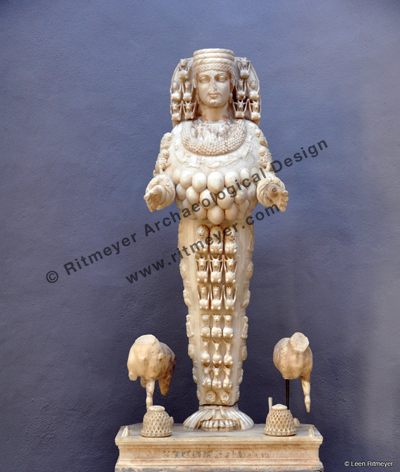

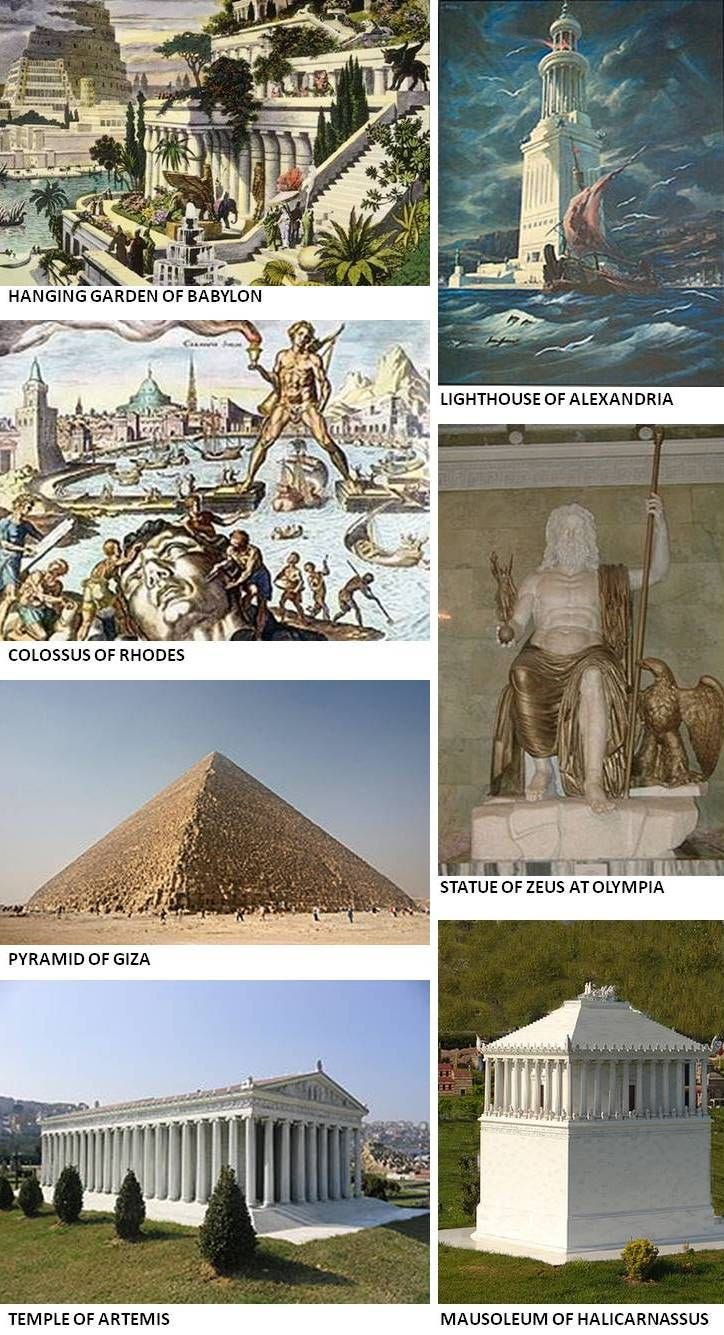



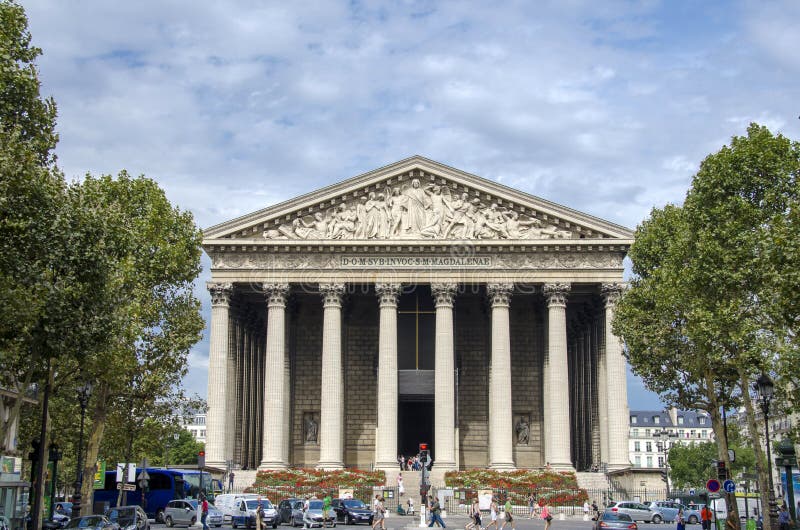
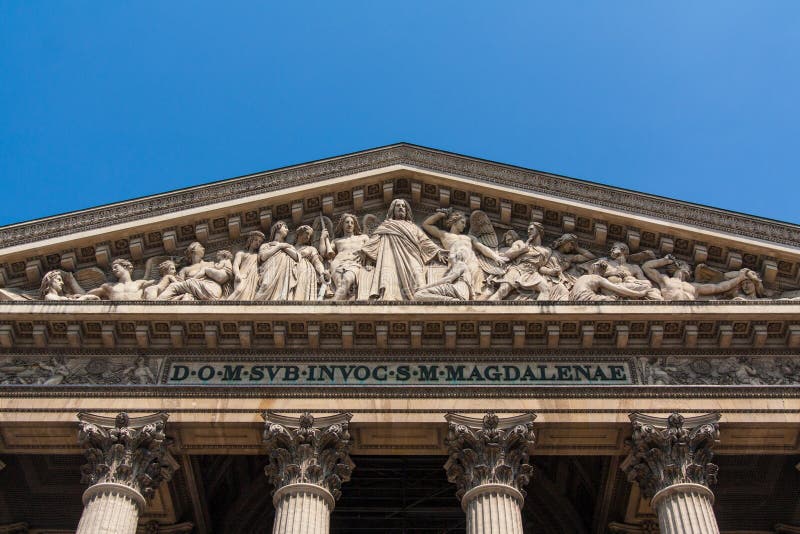

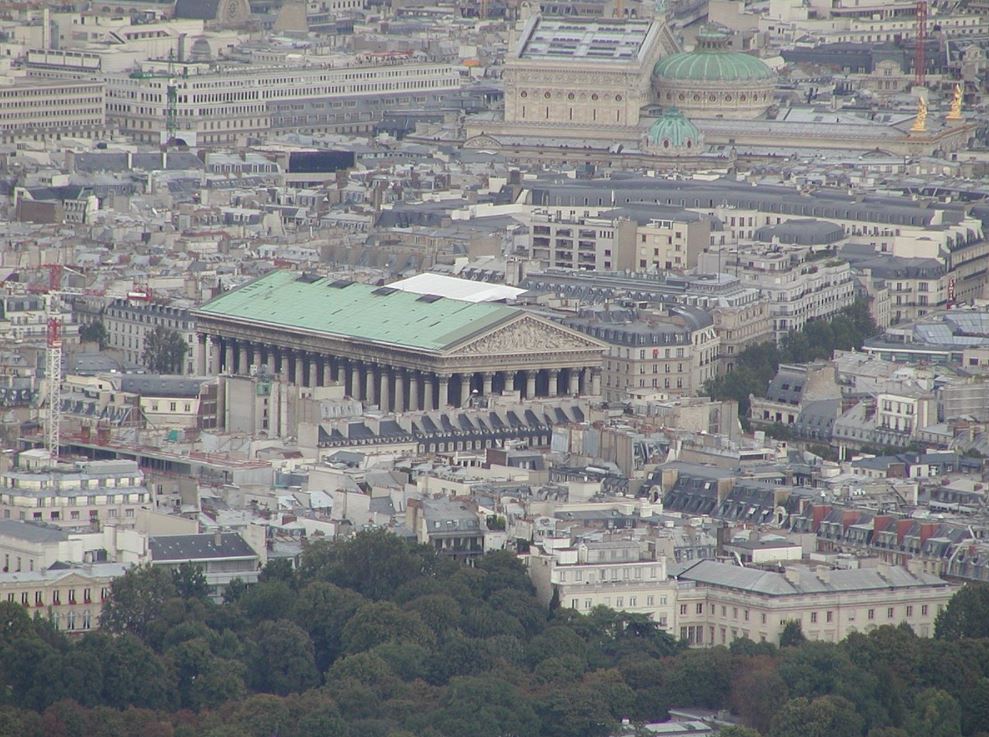
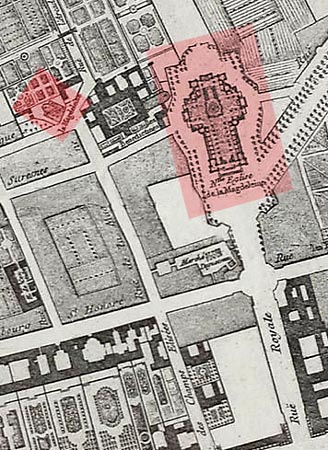



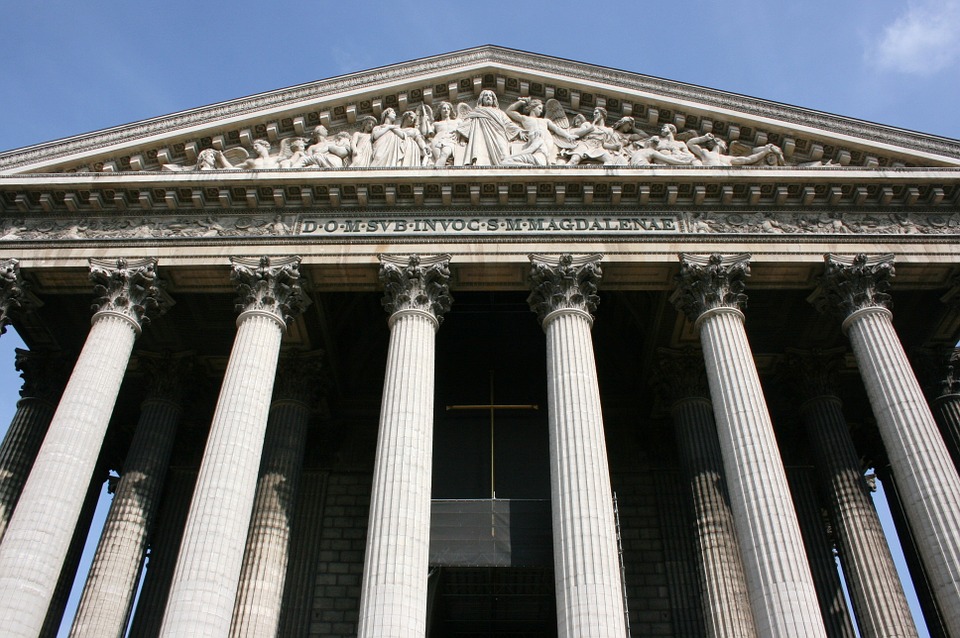
![PDF] Applying Golden Ratio in Product Packaging and Its Effect on Consumer ' s Buying Behaviour | Semantic Scholar](https://d3i71xaburhd42.cloudfront.net/c165da18263b580ae561090171c166c8fa054a6a/3-Figure1-1.png)

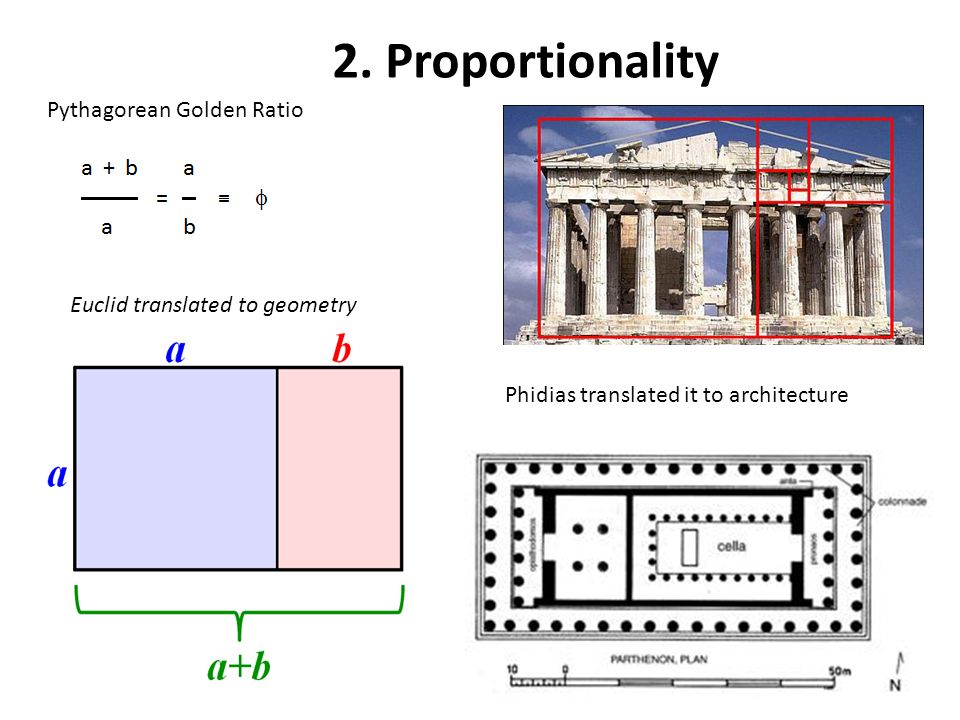


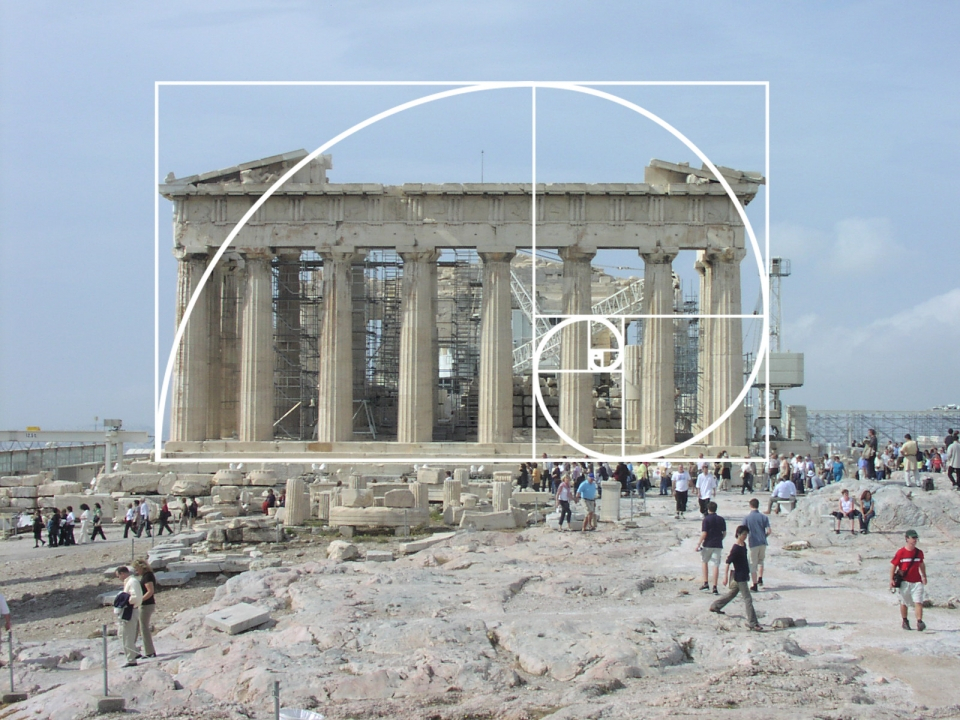

![The Pantheon and the golden rectangle [49] | Download Scientific Diagram](https://www.researchgate.net/publication/350876518/figure/fig2/AS:1012713207631873@1618461052910/The-Pantheon-and-the-golden-rectangle-49.png)
